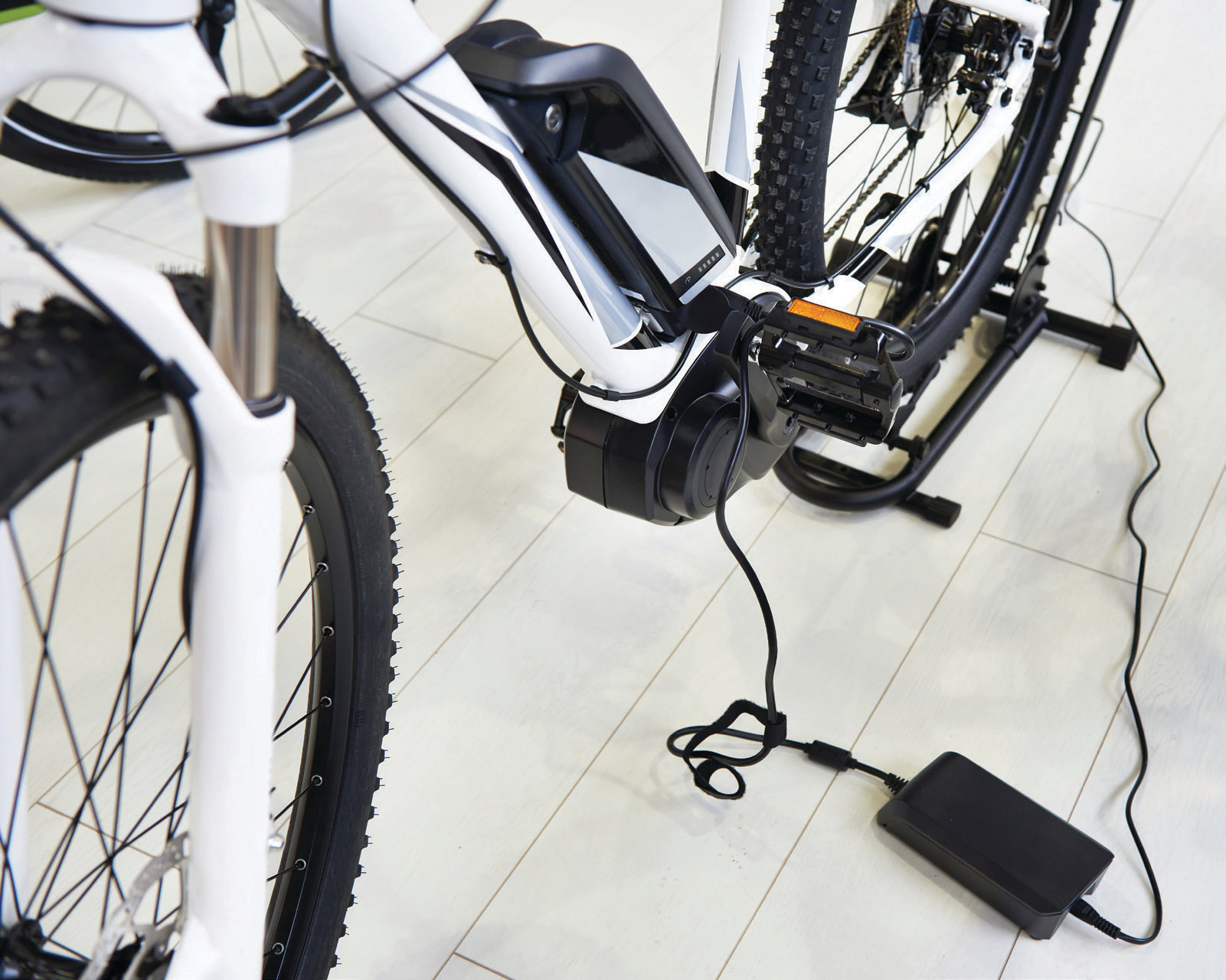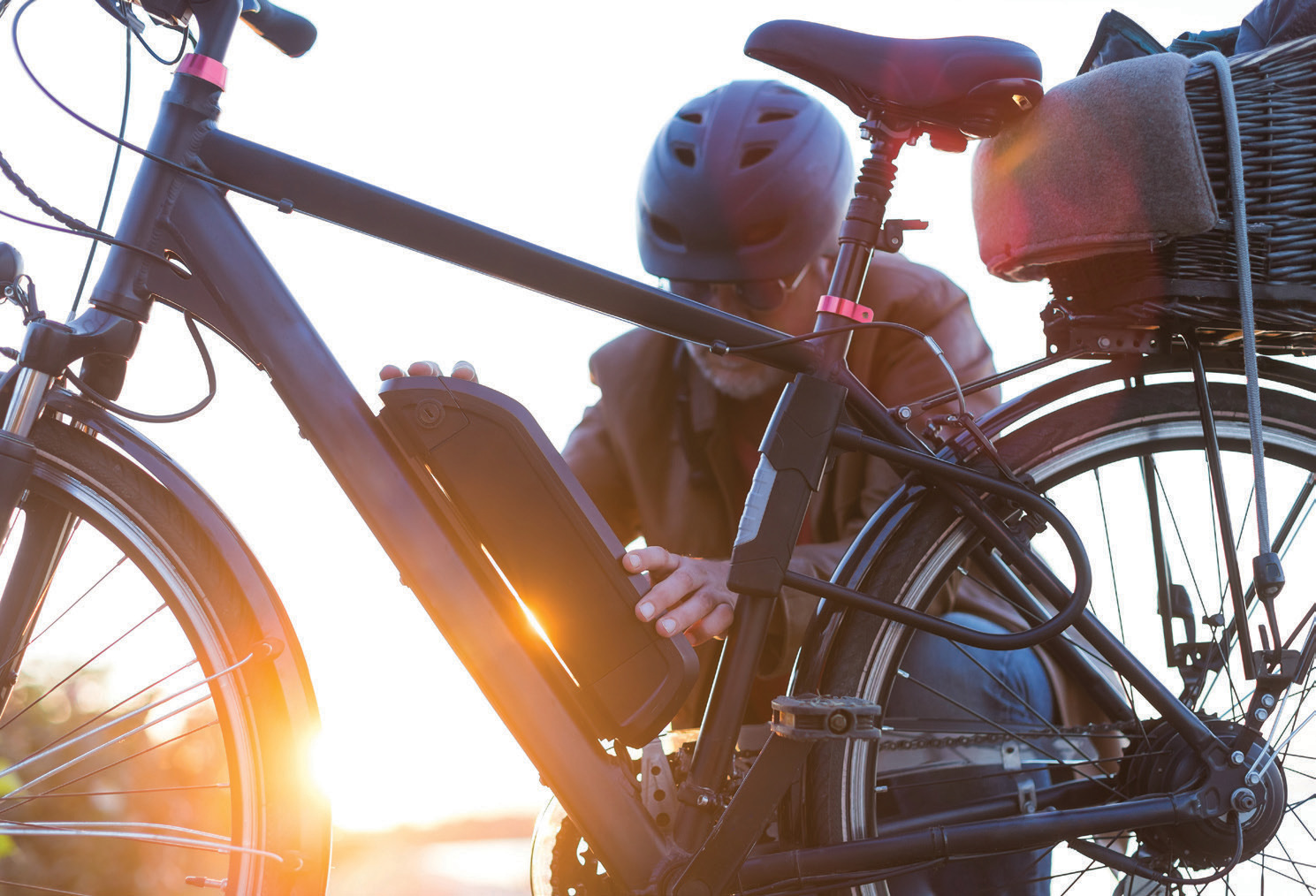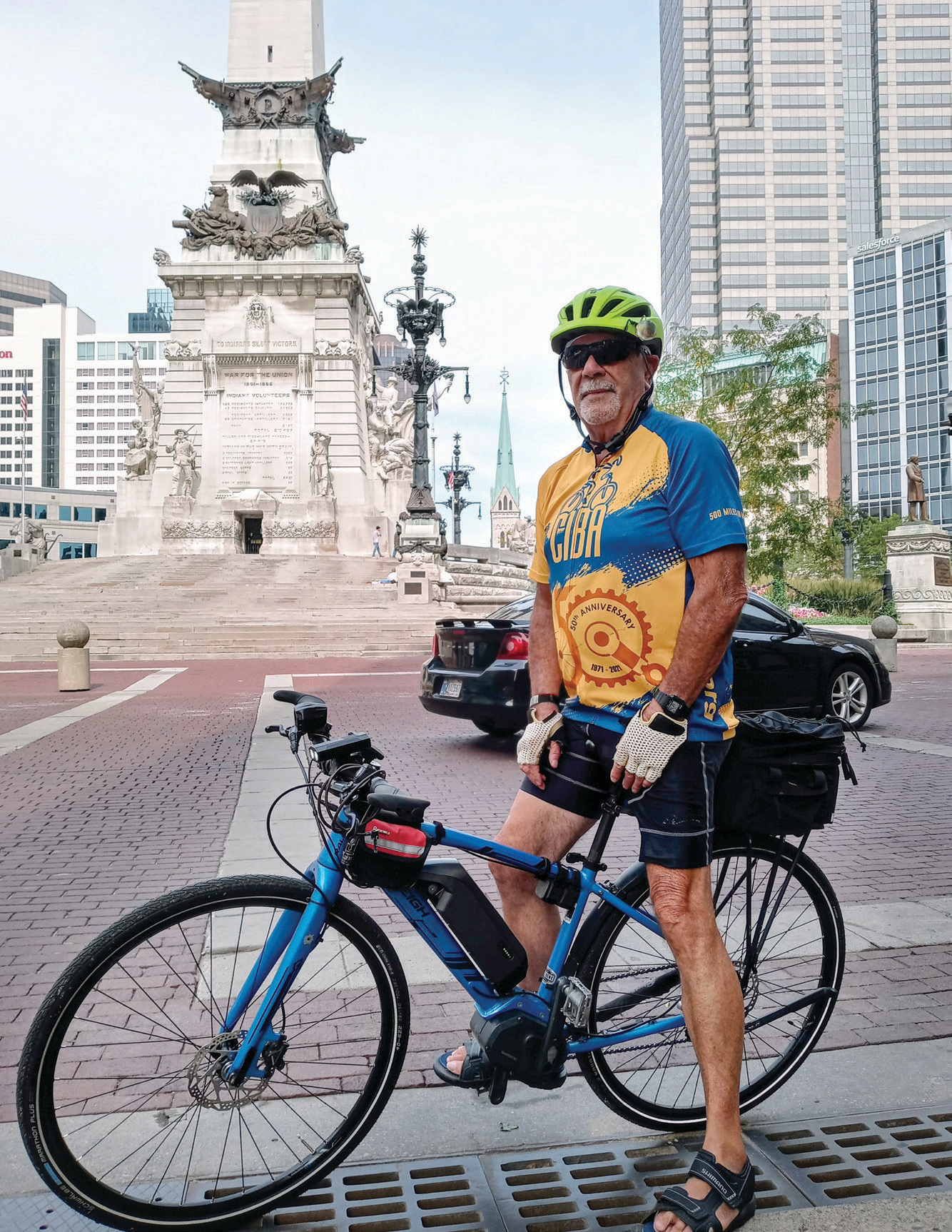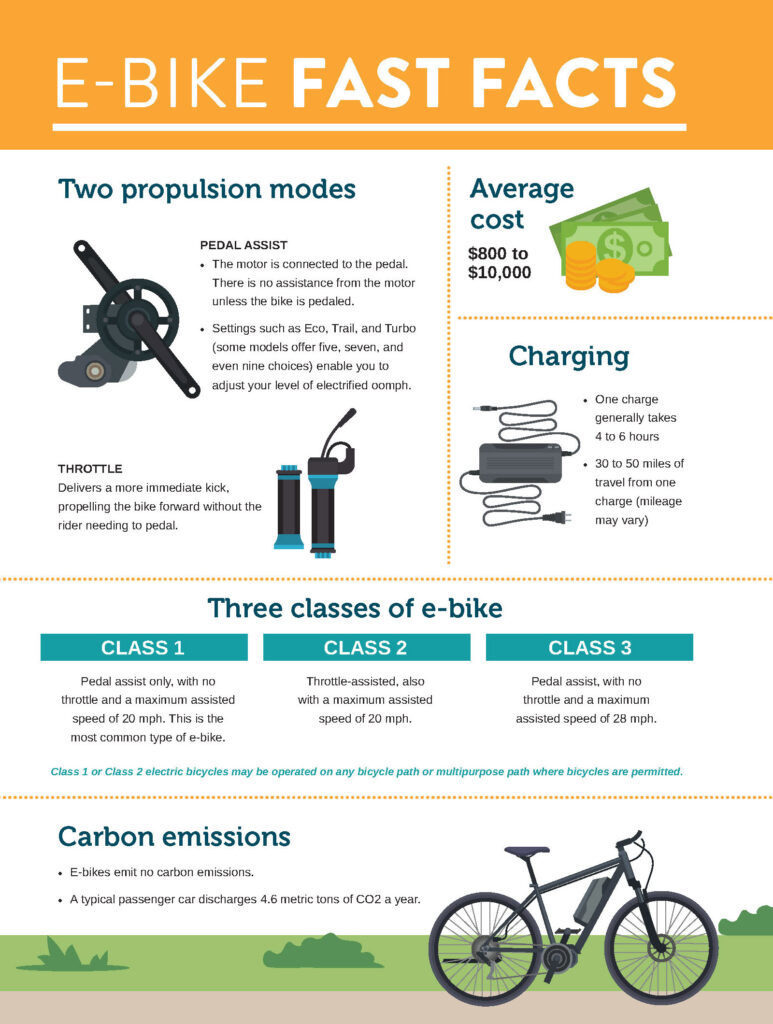
Electric bikes are becoming more popular as people find new ways to exercise or reduce their carbon footprint. Read on to learn how they work and whether an e-bike suits your lifestyle.
By Brian D. Smith
Electric bicycles may seem like a 21st-century phenomenon, but in fact, the first e-bike patent was granted in the ’90s — the 1890s.
That’s right: On the last day of 1895, a Canton, Ohio, man named Ogden Bolton Jr. received a patent for an “electrical bicycle” powered by a 10-volt battery. Bolton’s invention, while described by electricbike.com as looking “surprisingly modern” for its age, nevertheless lacked one feature that today’s cyclists tend to expect — pedals.
Even so, Bolton provided a peek into a future that would take more than a century to materialize. Not until the 1990s did interest in “electrical bicycles” resume in earnest, and between 2018 and 2022, e-bike sales in the United States nearly quadrupled, from 287,000 to 1.1 million, notes market research company Circana. The e-bike boom is resounding even louder overseas. In a $35 billion world market, China claims a nearly $11 billion share, and Germany $8 billion, compared to the United States’ $3.4 billion, according to Mordor Intelligence statistics.
Here in Indiana, e-bikes are wheeling their way into the local lifestyle. Order a Domino’s Pizza in Bloomington, and it might come on a motorized bicycle ridden by a so-called “Electric Bike Delivery Expert.” Grab lunch at Upland Brewery Co. in Jeffersonville, and you can rent an e-bike without ever leaving the building. Take a stroll on an Allen County hiking trail, and you may find it patrolled by an officer on an electric bicycle manufactured by Recon Power Bikes of Fort Wayne.
Not to mention the burgeoning number of everyday Hoosiers for whom the “E” in e-bikes stands for errands, exercise, enjoyment, and an easier commute to the office.
It’s also the first letter in “enigma,” which describes the perception of many non-cyclists who have never seen, let alone ridden on one. For the uninitiated, E-bikes 101 is now in session.
AN ARRAY OF OPTIONS
The e-bike is a bicycle equipped with an electric motor and one or both of two propulsion modes: pedal assist and throttle.
Pedal assist adds punch to each push of a pedal. “Pedal assist means no assistance from the motor unless you pedal, which amplifies your power. The motor is connected to your pedal,” said Rob Ling, mechanic for Gray Goat Bicycle Co., which has three locations in the Indianapolis area.
Pedal-assist settings such as Eco, Trail, and Turbo (some models offer five, seven, and even nine choices) enable you to adjust your level of electrified oomph. The higher modes boost your speed and allow you to surmount steeper inclines with increasing ease. If you haven’t ridden a bike since you passed driver’s ed, the assist feature may inspire you to shout, “Power to the pedal!”
The throttle delivers a more immediate kick, propelling the bike forward without the rider needing to pedal. But not too fast forward. The maximum speed of e-bikes is not only limited but also regulated. The 3-Class System, devised a decade ago and cited in Indiana law, divides e-bikes into three categories:
- Class 1: Pedal assist only, with no throttle and a maximum assisted speed of 20 mph. This is the most common type of e-bike.
- Class 2: Throttle-assisted, also with a maximum assisted speed of 20 mph.
- Class 3: Pedal assist, with no throttle and a maximum assisted speed of 28 mph.

Here’s where we get involved with the law. Considering that most e-bikes cost anywhere from $800 to $10,000, it’s natural to wonder how much insurance you’re required to buy, where you get a license and registration, and whether you can drive it on state park trails.
Now for the good news — at least if your bike is a Class 1 or 2. To quote the Indiana Code: “An electric bicycle is not a motor vehicle … An electric bicycle shall be regulated as a bicycle.”
Does this mean you don’t need insurance, a license, or registration? Yes, the operator of an electric bicycle is not required to have a driver’s license or liability coverage. As for those park trails: “Class 1 or Class 2 electric bicycles may be operated on any bicycle path or multipurpose path where bicycles are permitted.”
So there you have it, straight from our elected legislators: A bike is a bike is a bike. The motor doesn’t matter. But do you even need one?
After all, the basic bicycle has been around for 200 years, and you will burn more calories if techno-wizardry isn’t doing half the pedaling. You can’t blame a seasoned rider for decrying the pedal assist and throttle as unneeded at best and cheating at worst.
However, the target audience for e-bikes is not the U.S. Olympic Cycling Team. “Some people are just starting back into being active,” explained Ling. “Some people have a spouse who’s a hardcore cyclist, and they want to ride together, but the other one can’t keep up.”
Yet another group includes office workers who don’t want to arrive at their jobs bearing the residue of a heavy summer workout. “Not a lot of employers have shower facilities,” he said. Even members of northern Indiana’s Amish community have taken to e-bikes, said Max Hall, a mechanic for Pumpkinvine Cyclery of Middlebury. Some Amish use solar panels to recharge their batteries.

A GREENER OPTION
It’s worth noting that the e-bike isn’t always competing with the regular bike — sometimes, it competes with the automobile. Whether their motives are ecological or economical, owners of electric bicycles can find plenty of reasons to advocate for power.
If you’re seeking transitions from carbon emissions, you will relish the e-bike battery’s zero output, a dramatic decrease from the 4.6 metric tons of CO2 that a typical passenger car discharges each year.
If you’re a cash-conscious consumer, you’ll appreciate paying about a dime or less for each battery recharge, generally a 4- to 6-hour process that will grant you a fresh 30 to 50 miles of fossil-free travel (your mileage may vary).
Of course, you won’t ride your e-bike every day in Indiana — extreme cold, heavy snow, hail, and thunderstorms might prompt a reintroduction to internal combustion. But if you usually fill up your tank once a week, you probably spend about $2,000 to $2,500 per year on fuel costs. Every week you are able to drain your e-bike battery instead of your gas tank is almost like finding a $50 bill (or at least two twenties) in your glove compartment.
CONTINUING A PASSION

It would seem obvious that e-bike riders burn fewer calories than regular cyclists — about 20 to 30 percent, studies confirm. However, further research by the International Journal of Behavioral Nutrition and Physical Activity found that e-bike enthusiasts spent more time riding and covered more distance than traditional cyclists, resulting in more overall physical activity.
And it’s not as if every e-biker deserves the label of American idle. Joe Hettle of Brownsburg, 76, was an avid rider for decades until 2015 when the Vietnam veteran encountered an enemy he couldn’t vanquish — an array of health woes stemming in part from his exposure to Agent Orange.
A veteran cyclist who had organized bike rides and lectures for the Central Indiana Bicycling Association, Hettle suddenly discovered he could no longer keep up with the pack. The moment of truth came when he entered a race and finished with a result that, under normal circumstances, would have been embarrassing. “Out of over 100 riders,” he recalled, “I was the last one in.”
The circumstances, however, were anything but normal. In the years since, Hettle has been diagnosed with emphysema, asthma, coronary artery disease, and two forms of cancer. He compares his lung problems to “holding your nose, putting a McDonald’s straw in your mouth and trying to breathe.”
The timing of the e-bike’s availability in Indianapolis couldn’t have been better for Hettle. Faced with the prospect of parking his bicycle permanently, he went to a local bike shop and learned that electric models had hit the market but weren’t yet obtainable in Indy. Rather than cool his active heels, he told the shop, “If you order it in and I can’t ride it, I’ll pay the return shipping.”
Hettle got his e-bike — and has since ridden it more than 30,000 miles. “I’ve not had anybody tell me, ‘You can’t ride here,’” he said. “I bought it so I could keep up with my friends, not go faster.”
Down on the Ohio River, Grace Washburn sees plenty of friends riding e-bikes for the first time together as rental clients of The Bicycle Station. Her bike shop offers easy access to the 7.5-mile Ohio River Greenway, and it never hurts to be located within Upland Brewery.
“A lot of people will come over here after having lunch or brunch,” said Washburn, business development manager and a former Indiana University Women’s Little 500 championship team member. “You can take the bikes over the pedestrian bridge and go into Louisville.”
The Bicycle Station, located in Jeffersonville and Columbus, is among an assortment of bike shops across the state that rent e-bikes. Besides catering to tourists, they give potential e-bike buyers the opportunity to take the electric two-wheeler on the road for an hour or even a full day rather than giving it an abbreviated test drive.
DESIGNED FOR LAW ENFORCEMENT
Just remember that if you get a bit reckless on your rented e-bike, you may someday find yourself getting pulled over by the lights and siren of … another e-bike, likely assembled in Fort Wayne. Recon Power Bikes is the leading supplier of e-bikes for law enforcement. It sells its “military tough” products to police departments in all 50 states, federal agencies ranging from the U.S. Fish and Wildlife Service to the FBI, campus cops, and even the U.S. Army and U.S. Air Force.
“From day one, we designed and marketed to law enforcement,” said Tim Burns, sales and dealer development manager. Recon representatives would rent a booth at the International Association of Chiefs of Police Annual Conference and Exposition. The Fort Wayne e-bikes add a new dimension to traditional police bike patrols, allowing officers to stay fresher and move faster to trouble spots when necessary.
A contract with the FBI in 2019 was “the turning point for us as a company,” Burns said. In late 2022, Recon joined forces with GMC to create an all-wheel-drive Hummer electric bike featuring twin motors, puncture-resistant 4-inch tires, and ride modes called Cruise, Traction, and Adrenaline. Like other Recon e-bikes, it’s built to handle everything from deep snow and sand to concrete curbs and stairs.
In the company’s backyard, the Allen County Sheriff’s Department is constructing what Recon founder Jeff Fuze called the “first e-bike law enforcement training facility in the world” on the 200-acre sheriff’s department regional training site in southeast Fort Wayne.
But Recon isn’t all blue and green — civilians are welcome to mobilize a line of e-bikes with names like Sortie and Commando. Prices range from about $2,000 to $4,000.
SHRINKING DISTANCES AND FLATTENING HILLS
Should everyone own an electric bike? The charged debate rolls on.
Longtime cyclist Hettle doesn’t think so. “If you’re healthy, you don’t need an e-bike,” he said. “But if you have health issues, step up and get one.”
Not that he considers his own e-bike anything less than the regular bicycles he used to be able to ride. “As long as I have to pedal it,” said Hettle, “it’s a bicycle.”
But in a near-radical counterpoint to the electric vehicle movement, an Outside magazine article argues that not only are e-bikes worth buying — they are worth buying instead of electric cars.
“Whatever your goal — to save money, the planet, or your sanity and health,” wrote Joe Lindsey, “the EV that will change your life isn’t a car, truck, or SUV. It’s an e-bike … I’m saying keep your old car, get an e-bike, and use it to replace car trips…The addition of lightweight electric motor-assist is the secret sauce that transforms the e-bike experience … E-bikes shrink distances and flatten hills.”
All of this is not to say that everyone should rush right out and buy an e-bike. They’re not inexpensive, and depending on your location, they may or may not add convenience to your life. But whatever you do, know what you really want.
Burns recalled a man who entered his company’s showroom one day and, as the conversation turned to e-bikes, began describing his dream two-wheeler: “I want a bike that’ll go 50 miles an hour and not have to pedal it.”
Said Burns: “Then you need to buy a motorcycle.”




